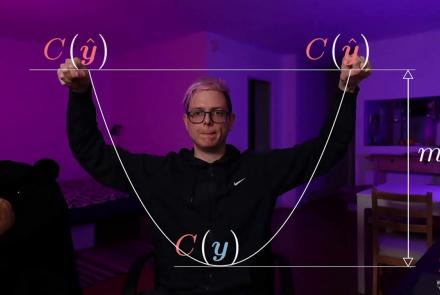This tutorial walks participants through the application of dynamic causal modelling (DCM) to fMRI data using MATLAB. Participants are also shown various forms of DCM, how to generate and specify different models, and how to fit them to simulated neural and BOLD data.
This lesson corresponds to slides 158-187 of the PDF below.
Difficulty level: Advanced
Duration: 1:22:10
Speaker: : Peter Bedford, Povilas Karvelis
Course:
This lecture presents an overview of functional brain parcellations, as well as a set of tutorials on bootstrap agregation of stable clusters (BASC) for fMRI brain parcellation.
Difficulty level: Advanced
Duration: 50:28
Speaker: : Pierre Bellec
This tutorial covers LV-EBM to target prop to (vanilla, denoising, contractive, variational) autoencoder and is a part of the Advanced Energy-Based Models module of the the Deep Learning Course at NYU's Center for Data Science. Prerequisites for this course include: Energy-Based Models I, Energy-Based Models II, Energy-Based Models III, Energy-Based Models IV, and an Introduction to Data Science or a Graduate Level Machine Learning course.
Difficulty level: Advanced
Duration: 1:00:34
Speaker: : Alfredo Canziani
This tutorial covers the concepts of autoencoders, denoising encoders, and variational autoencoders (VAE) with PyTorch, as well as generative adversarial networks and code. It is a part of the Advanced energy based models modules of the the Deep Learning Course at NYU's Center for Data Science. Prerequisites for this course include: Energy-Based Models I, Energy-Based Models II, Energy-Based Models III, Energy-Based Models IV, Energy-Based Models V, and an Introduction to Data Science or a Graduate Level Machine Learning course.
Difficulty level: Advanced
Duration: 1:07:50
Speaker: : Alfredo Canziani
This tutorial covers advanced concept of energy-based models. The lecture is a part of the Associative Memories module of the the Deep Learning Course at NYU's Center for Data Science.
Difficulty level: Advanced
Duration: 1:12:00
Speaker: : Alfredo Canziani
Course:
This tutuorial covers the concept of graph convolutional networks and is a part of the Deep Learning Course at NYU's Center for Data Science. Prerequisites for this module include: Modules 1 - 5 of this course and an Introduction to Data Science or a Graduate Level Machine Learning course.
Difficulty level: Advanced
Duration: 57:33
Speaker: : Alfredo Canziani
Course:
This lecture covers the concept of model predictive control and is a part of the Deep Learning Course at NYU's Center for Data Science. Prerequisites for this module include: Models 1-6 of this course and an Introduction to Data Science or a Graduate Level Machine Learning course.
Difficulty level: Advanced
Duration: 1:10:22
Speaker: : Alfredo Canziani
Course:
This lecture covers the concepts of emulation of kinematics from observations and training a policy. It is a part of the Deep Learning Course at NYU's Center for Data Science. Prerequisites for this module include: Models 1-6 of this course and an Introduction to Data Science or a Graduate Level Machine Learning course.
Difficulty level: Advanced
Duration: 1:01:21
Speaker: : Alfredo Canziani
Course:
This lecture covers the concept of predictive policy learning under uncertainty and is a part of the Deep Learning Course at NYU's Center for Data Science. Prerequisites for this module include: Models 1-6 of this course and an Introduction to Data Science or a Graduate Level Machine Learning course.
Difficulty level: Advanced
Duration: 1:14:44
Speaker: : Alfredo Canziani
Course:
This lecture continues on the topic of descent from the previous lesson, Optimization I. This lesson is a part of the Deep Learning Course at NYU's Center for Data Science. Prerequisites for this module include: Models 1-7 of this course and an Introduction to Data Science or a Graduate Level Machine Learning course.
Difficulty level: Advanced
Duration: 1:51:32
Speaker: : Alfredo Canziani
Course:
This lecture describes the principles of EEG electrode placement in both 2- and 3-dimensional formats.
Difficulty level: Intermediate
Duration: 12:16
Speaker: : Mike X. Cohen
Course:
This tutorial walks users through performing Fourier Transform (FFT) spectral analysis of a single EEG channel using MATLAB.
Difficulty level: Intermediate
Duration: 13:39
Speaker: : Mike X. Cohen
Course:
This tutorial builds on the previous lesson's demonstration of spectral analysis of one EEG channel. Here, users will learn how to compute and visualize spectral power from all EEG channels using MATLAB.
Difficulty level: Intermediate
Duration: 12:34
Speaker: : Mike X. Cohen
Course:
In this lesson, users will learn more about the steady-state visually evoked potential (SSEVP), as well as how to create and interpret topographical maps derived from such studies.
Difficulty level: Intermediate
Duration: 9:10
Speaker: : Mike X. Cohen
Course:
This lesson teaches users how to extract edogenous brain waves from EEG data, specifically oscillations constrained to the 8-12 Hz frequency band, conventionally named alpha.
Difficulty level: Intermediate
Duration: 13:23
Speaker: : Mike X. Cohen
Course:
In the final lesson of this module, users will learn how to correlate endogenous alpha power with SSVEP amplitude from EEG data using MATLAB.
Difficulty level: Intermediate
Duration: 12:36
Speaker: : Mike X. Cohen
Course:
This lecture introduces neuroscience concepts and methods such as fMRI, visual respones in BOLD data, and the eccentricity of visual receptive fields.
Difficulty level: Intermediate
Duration: 7:15
Speaker: : Mike X. Cohen
Course:
This tutorial walks users through the creation and visualization of activation flat maps from fMRI datasets.
Difficulty level: Intermediate
Duration: 12:15
Speaker: : Mike X. Cohen
Course:
This tutorial demonstrates to users the conventional preprocessing steps when working with BOLD signal datasets from fMRI.
Difficulty level: Intermediate
Duration: 12:05
Speaker: : Mike X. Cohen
Course:
In this tutorial, users will learn how to create a trial-averaged BOLD response and store it in a matrix in MATLAB.
Difficulty level: Intermediate
Duration: 20:12
Speaker: : Mike X. Cohen
Topics
- Bayesian networks (2)
- (-) Clinical neuroinformatics (2)
- Standards and Best Practices (1)
- Notebooks (1)
- (-) Neuroimaging (20)
- Machine learning (4)
- Tools (7)
- Workflows (2)
- Animal models (1)
- Clinical neuroscience (1)
- General neuroscience (6)
- Computational neuroscience (18)
- Statistics (3)
- Computer Science (1)
- (-) Genomics (5)
- Data science (2)
- Open science (4)




















